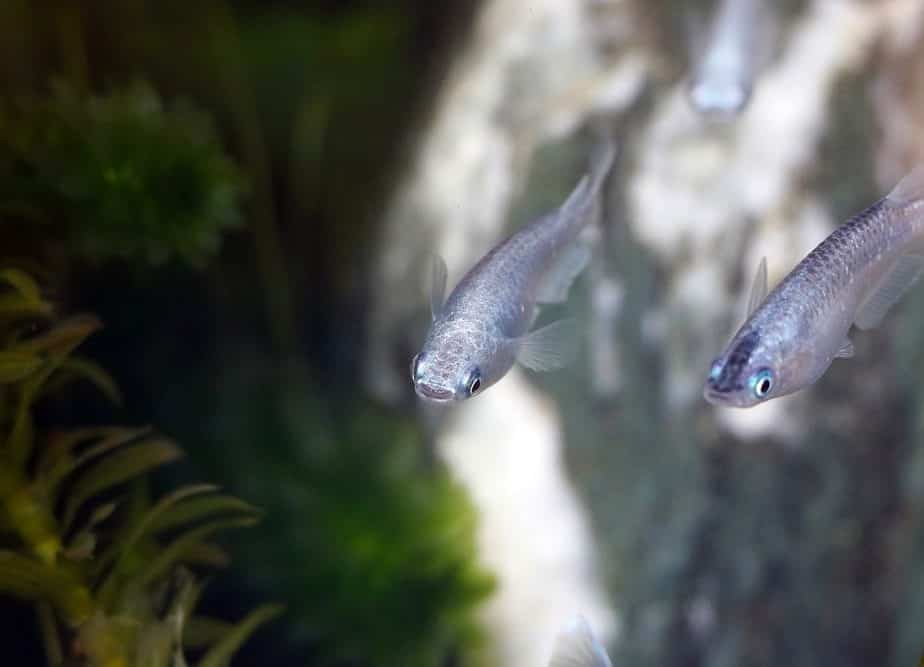
Japanese ricefish, or medaka, are becoming more popular beyond Japan and other Asian countries where these fish have been well known and appreciated for a long time.
Medaka, or Japanese ricefish, are hardy, low-maintenance fish. They are also playful and beautiful to watch. They come in hundreds of colors and various shapes. Japanese ricefish do great in community aquariums with other peaceful tank mates.
Since medaka fish are still relatively rare in many countries, prospective and new fish keepers often ask the same questions about this fish species.
JAPANESE RICEFISH: FREQUENTLY ASKED QUESTIONS
1. What Kind of Fish Is Medaka/ Japanese Ricefish? Is Japanese Ricefish the Same as Killifish?
Medaka belongs to the family Adrianichthyidae, which includes ricefishes, the subfamily Oryziinae, genus Oryzias. The scientific name for Japanese ricefish is Oryzias latipes, registered as a distinct species in 1846.
Japanese ricefish, or Medaka, is often referred to as Japanese killifish. Killifish is an accepted common name for Medaka but Medaka is not a killifish species.
Per the Integrated Taxonomic Information System (ITIS), Medaka Ricefish and killifish belong to the same superorder Acanthopterygii but split into different orders and families. Although Medaka is not killifish, Japanese killifish is still an acceptable term for this species, according to ITIS.
2. What Do Medaka Fish Eat?
Japanese ricefish are omnivores; they are not picky. They eat various meat or plant-based foods, including commercial pellets and flakes, small pieces of vegetables, algae, bloodworms, mosquito larvae, and brine shrimp.
Japanese ricefish are surface feeders. Feed your fish once or twice a day and avoid overfeeding them. Whatever the fish can consume within about three minutes is sufficient for most fish, including Medaka.
Although Japanese ricefish are so easy to please regarding their meal options, variety is essential. Your fish will be healthier and stronger if they consume different kinds of foods in the right amounts.
3. Will Medaka Eat Their Eggs And Fry?
Medaka will eat their eggs and small fry if the eggs are not separated from them in time. However, juveniles a few weeks apart can peacefully coexist in one fish tank.
If you want to breed Japanese ricefish, it is good to use a Java moss plant or an artificial spawning plant. Fish will deposit and hide eggs on the plant or sponge. Then you can easily remove the plant with the eggs attached to it and place it in a separate aquarium.
Medaka eggs hatch offspring within three weeks.
We will discuss tactics to prevent Japanese ricefish from mating. However, if you want your Medaka to breed and are interested in mixing different types of Medaka, you are welcome to read our post to learn more.
4. How to Prevent Medaka From Breeding
Japanese ricefish are very easy to breed but many pet fish owners would rather prevent overcrowding the tank. So, you might wonder how to discourage your fish from reproducing.
For any species of fish and mollusks, the confined space of the aquarium and portioned nutrition is a limiting factor controlling proliferation. Older fish will consume small ones because they compete for resources.
Japanese ricefish are a schooling species at their core. They need company.
In general, you can keep male and female fish together. Japanese ricefish are not aggressive so you can keep species of opposite sexes together.
A few points in bulleted form:
- If you do not remove the eggs deposited by the female from the aquarium, older fish will eat the eggs or fry if any of the eggs do hatch
- If the conditions are not optimal, for example, if the temperature of the water is on the lower end of the acceptable range or the tank is getting crowded, the female will not deposit eggs
- If the tank is already densely populated and there is not much room to breed, that alone could be an important factor in preventing your Medaka from breeding.
5. How to Tell the Difference Between Female and Male Medaka
The difference between female and male Medaka fish is not as obvious as between some more common pet fish.
You can still tell the difference between male and female Japanese ricefish if you know what to look for. You can differentiate by comparing the shape of their fins and torsos:
- Females have a more triangular anal fin, while the rays of a male’s anal fin are more parallel to each other
- The dorsal fin in males has more separation between the hind rays from the rest of the rays than the dorsal fin of females
- Female medaka have a more barrel-shaped, rounder, torsos
A peer-reviewed article published in Science Direct, exploring the subject of sex determination in Medaka, offers a good visual comparison of male and female specimens.
6. Are Japanese Ricefish Schooling Fish?
Medaka ricefish are social, peaceful, schooling fish. They should be kept in groups of at least six specimens. Pet stores typically sell them in groups of about six, too. Medaka fish are not likely to get stressed out even if you add more fish of this breed than the ideal six or eight – they thrive in large groups of their kind.
Medaka fish do not always stay together a classic school of fish and can behave somewhat independently in the tank.
Japanese ricefish do well with other docile fish that need similar aquarium conditions. They can even do well with relatively aggressive tank mates, such as Betta if the conditions are good for both species in the aquarium.
However, other species do not replace the companionship of fellow Medaka. Note that these fish will mate with other strains of Japanese ricefish because they belong to the same species.
7. Are Japanese Ricefish Fin Nippers?
Japanese ricefish are not aggressive or known to be fin nippers.
As long as the conditions in the aquarium are good, the tank is not overcrowded, and your Japanese ricefish live in a school of at least six, they leave other fish alone. Medaka is not known to nip the fins of even fish with very long fins and tails.
8. Can Betta Fish Live with Japanese Ricefish?
Bettas and Japanese ricefish are a good match in terms of the parameters required to thrive in their living environments. The two species also have personalities that are generally compatible. As long as the fish tank is spacious enough and the conditions are right for both species, Medaka and bettas will get along.
Medaka fish are likely to live peacefully with various tank mates but bettas are known to be territorial. For that reason, it is important to add the right species to any aquarium with one or more bettas living in it.
Japanese ricefish are very docile and non-aggressive. They are not prone to nipping the fins of other fish, which is especially important if you have a male betta. Keep your Medaka in a school of 6 or more for their comfort and confidence, even if they do not have other tank mates.
The parameters of the living environment, including temperature, acidity, and hardness, needed by betta and Japanese ricefish, overlap. So, there is a range that will be comfortable for both fish species.
In other words, Medaka and betta are good neighbors for each other.
9. Will Goldfish Eat Medaka Fish?
Goldfish are popular aquarium fish and many owners wonder if Medaka could be a good addition to a community tank with Goldfish in it.
Goldfish might eat your Medaka. Goldfish and Medaka could coexist peacefully in one community tank but it is hard to guarantee a positive outcome. The difference in the size between the two species is so significant that it is easy for Goldfish to swallow a little Japanese ricefish, even unintentionally.
The best way to reduce the possibility that one of your fish will eat another is to ensure that the tank provides ample room and proper conditions for all the fish to live happily.
10. Can Japanese Ricefish Live Outdoors?
Japanese ricefish do very well in ponds or fish tanks placed outdoors unless you live in a climate where temperature extremes are common.
Medaka fish tolerate a wide range of temperatures. 16-25°C (60-77°F) is the ideal range for them but they can tolerate colder conditions for limited periods (a few days).
If you want to encourage these hardy fish to mate, then it is important to keep Medaka in the tank with water in the ideal range of temperatures.
If the water is regularly warmer by a few degrees than the ideal range, Medaka will tolerate it but will not mate. There is evidence pointing at a reduced lifespan due to living in warmer-than-ideal water as well.
11. How to Retrieve Medaka Eggs
The best way to retrieve and secure Medaka eggs is to keep a natural or artificial plant or a mop object in the fish tank where your fish might mate. The object serves as a spawning plant.
The eggs will be quite visible on the java moss or another plant you place in the tank. You can remove the plant when you notice eggs on it and place it into a separate fish tank.
Less than three weeks after being deposited, Japanese ricefish eggs will hatch and produce baby fish.
12. Do Medaka Fish Tolerate a Bubbler or a Fountain?
Japanese ricefish do fine with a fountain or a small bubbling filter if there is still ample room in the tank where there is no flow or the flow is minimal.
Medaka fish live in shallow and still rice fields in their natural habitats, so these fish do best in still or slow waters. Ideally, the aquarium should replicate their natural habitat conditions as closely as possible. So, water movement is okay, as long as most of your fish tank is still placid and slow-moving.
13. How Quickly Do Japanese Ricefish Grow?
Medaka juveniles reach their adult size and color within about 3 weeks. Nutrition and proper environmental conditions are essential in helping fry reach its maximum size and develop full features.
Juveniles do very well with younger fry and do not eat or attack them. Adult fish, however, will consume eggs and juveniles of their species.
14. How Many Japanese Ricefish Can You Keep In a 10-gallon Tank?
Six-eight Medaka fish is the ideal size of the school for a 10-gallon fish tank. Avoid keeping less than four Japanese ricefish due to their need for companionship. Usually, even twelve – fourteen Medaka should still be okay for a 10-gallon tank, as long as the tank is comfortable for the fish.
If you keep more than a dozen Japanese ricefish in a 10-gallon aquarium, avoid adding other fish species to prevent stress in your pet fish.
Recent Posts
Asian stone catfish (Hara jerdoni) are hardy, peaceful fish. They do well in a compact space and do not need a heater. These docile and easy fish are great for community aquariums and suitable for...
Classic Oryzias latipes specimens are of beautiful silver color but these fish come in many hues and colors in the wild and captivity. You might wonder if specimens of different colors and with...

